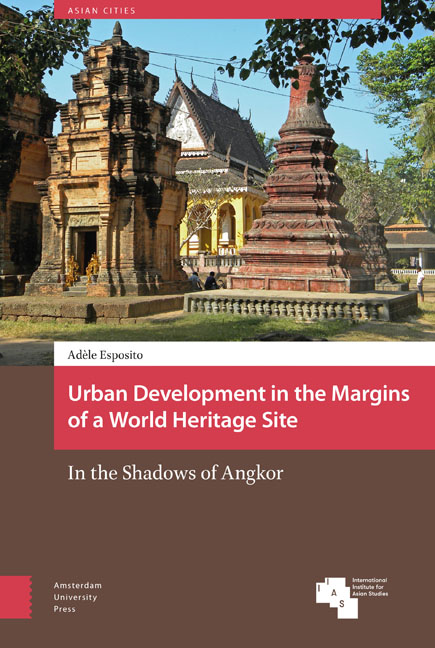Book contents
- Frontmatter
- Dedication
- Contents
- List of Figures
- Abbreviations
- Glossary of Khmer terms
- Acknowledgements
- Author’s Preface
- Introduction
- 1 ‘Before you Build a Wall, Think of What You are Leaving Outside it’: The Construction of Core and Marginal Spaces in the Angkor Region
- 2 The Arena of Urban Planning and the Idea of the City
- 3 The City as Developers’ Playground
- 4 The Architectural Space: How Contemporary Design Shapes Urban Identities and Ideas of Modernity
- Conclusion
- Bibliography
- Index
- Publications / Asian Cities
1 - ‘Before you Build a Wall, Think of What You are Leaving Outside it’: The Construction of Core and Marginal Spaces in the Angkor Region
Published online by Cambridge University Press: 16 February 2021
- Frontmatter
- Dedication
- Contents
- List of Figures
- Abbreviations
- Glossary of Khmer terms
- Acknowledgements
- Author’s Preface
- Introduction
- 1 ‘Before you Build a Wall, Think of What You are Leaving Outside it’: The Construction of Core and Marginal Spaces in the Angkor Region
- 2 The Arena of Urban Planning and the Idea of the City
- 3 The City as Developers’ Playground
- 4 The Architectural Space: How Contemporary Design Shapes Urban Identities and Ideas of Modernity
- Conclusion
- Bibliography
- Index
- Publications / Asian Cities
Summary
In the ancient Khmer language, the word ‘Angkor’ means ‘capital city’. Seven Khmer capitals, built between the ninth and fifteenth centuries, extended their power over a broad territory covered by rice fields, interspersed with sanctuaries and villages, and connected by roads and open-air water infrastructures. However, Angkor, as it has come to be understood today, bears no resemblance to this original usage. Instead, it conjures up either an exotic colonial past or a nation's ancient legacy and its vision for the future. When we say ‘Angkor’, we no longer mean a capital city but a social construct – a collective and selective symbol of a multi-layered historical, cultural, and social reality. And while it might appear that this construct has naturally blossomed from the passing of the centuries, it has only recently been developed in the official discourse of Cambodian and international institutions.
A well-entrenched and stable idea of heritage underpins this social construction. It is grounded in the notion of the ‘historic monument’, as European political and cultural elites have shaped this in modern times (Gillman, 2010), and assigns the highest importance to the historical, scientific, and artistic value of archaeological remains. In Cambodia, colonial and postcolonial institutions have, at times, adhered to this notion of heritage, while the international community represented by UNESCO has helped them to build a heritage management framework for the World Heritage site of Angkor that assigns the greatest importance to the remains dating from the ancient Khmer civilization.
In this chapter, I examine how the institutional practice of heritage took root in Cambodia in the late nineteenth century and beginning of the twentieth, under the influence of the French colonial power. I show how international organizations and donors involved in the conservation of Angkor have confirmed the validity of this heritage system2 for its conservation since the 1990s. This has produced a geographical hierarchy of core and marginal spaces in the Angkor region. The monuments and their immediate surroundings have been put at the core of the heritage management system, and the creation of archaeological parks has crystallized the idea of Angkor as an identifiable and delimited heritage space. However, this process has led to the marginalization of other types of legacy and space, which have ended up on the periphery of the archaeological parks and of heritage recognition.
- Type
- Chapter
- Information
- Urban Development in the Margins of a World Heritage SiteIn the Shadows of Angkor, pp. 51 - 92Publisher: Amsterdam University PressPrint publication year: 2018



